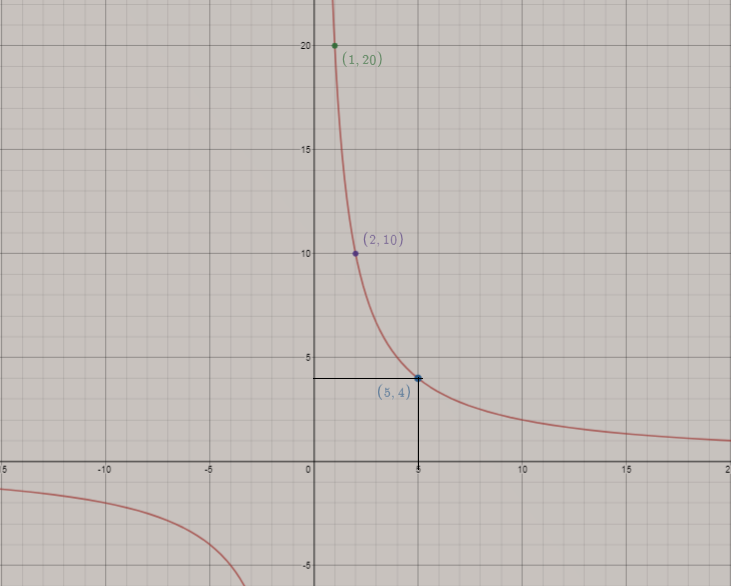
If xy = 20, x, y > 0. Use the graph to find y when x = 5?
Answer
530.1k+ views
Hint:
In the given question, we have been asked to find the value of y when x = 5 and the equation of a curve is given i.e. xy = 20. In order to find the value, first we need to draw the graph of the given equation by putting different values of ‘x’ and solve for the value of ‘y’. by on the graph of the equation draw a line parallel to y-axis from the point x = 5 and where it intersects the line of the given equation, from that point we will be able to find the value of ‘y’.
Complete step by step solution:
We have given that,
\[\Rightarrow xy=20\]
Solving the above given equation;
Put a different value of ‘x’ and solve for the value of ‘y’.
Now,
Putting x = 1
Solving for the value of ‘y’,
\[\Rightarrow 1\times y=20\]
Dividing both the sides of the equation by 1, we get
\[\Rightarrow y=20\]
Now,
Putting x = 2
Solving for the value of ‘y’,
\[\Rightarrow 2\times y=20\]
Dividing both the sides of the equation by 2, we get
\[\Rightarrow y=10\]
Therefore,
We got the points for the plotting of graph, i.e.
Graph of the equation xy = 20 is as below;

Now,
On the graph of the above equation, from the point 5 on the x-axis draw a line parallel to y-axis. Now the line intersects the line of the graph at a point, from there draw a line parallel to x-axis.
Both the lines intersect each other at the point (5, 4) i.e. when x = 5 means x-coordinate is equal to 5, then y will be equal to 4.
Therefore,
When, x = 5 we get, y = 4.
Note:
The important thing to recollect about any equation is that the ‘equals’ sign represents a balance. What the sign says is that what’s on the left-hand side is strictly an equal to what’s on the right-hand side. It is the type of question where only mathematical operations such as addition, subtraction, multiplication and division is used.
In the given question, we have been asked to find the value of y when x = 5 and the equation of a curve is given i.e. xy = 20. In order to find the value, first we need to draw the graph of the given equation by putting different values of ‘x’ and solve for the value of ‘y’. by on the graph of the equation draw a line parallel to y-axis from the point x = 5 and where it intersects the line of the given equation, from that point we will be able to find the value of ‘y’.
Complete step by step solution:
We have given that,
\[\Rightarrow xy=20\]
Solving the above given equation;
Put a different value of ‘x’ and solve for the value of ‘y’.
Now,
Putting x = 1
Solving for the value of ‘y’,
\[\Rightarrow 1\times y=20\]
Dividing both the sides of the equation by 1, we get
\[\Rightarrow y=20\]
Now,
Putting x = 2
Solving for the value of ‘y’,
\[\Rightarrow 2\times y=20\]
Dividing both the sides of the equation by 2, we get
\[\Rightarrow y=10\]
Therefore,
We got the points for the plotting of graph, i.e.
| x | Y |
| 1 | 20 |
| 2 | 10 |
Graph of the equation xy = 20 is as below;

Now,
On the graph of the above equation, from the point 5 on the x-axis draw a line parallel to y-axis. Now the line intersects the line of the graph at a point, from there draw a line parallel to x-axis.
Both the lines intersect each other at the point (5, 4) i.e. when x = 5 means x-coordinate is equal to 5, then y will be equal to 4.
Therefore,
When, x = 5 we get, y = 4.
Note:
The important thing to recollect about any equation is that the ‘equals’ sign represents a balance. What the sign says is that what’s on the left-hand side is strictly an equal to what’s on the right-hand side. It is the type of question where only mathematical operations such as addition, subtraction, multiplication and division is used.
Recently Updated Pages
Why are manures considered better than fertilizers class 11 biology CBSE

Find the coordinates of the midpoint of the line segment class 11 maths CBSE

Distinguish between static friction limiting friction class 11 physics CBSE

The Chairman of the constituent Assembly was A Jawaharlal class 11 social science CBSE

The first National Commission on Labour NCL submitted class 11 social science CBSE

Number of all subshell of n + l 7 is A 4 B 5 C 6 D class 11 chemistry CBSE

Trending doubts
What is meant by exothermic and endothermic reactions class 11 chemistry CBSE

10 examples of friction in our daily life

One Metric ton is equal to kg A 10000 B 1000 C 100 class 11 physics CBSE

1 Quintal is equal to a 110 kg b 10 kg c 100kg d 1000 class 11 physics CBSE

Difference Between Prokaryotic Cells and Eukaryotic Cells

What are Quantum numbers Explain the quantum number class 11 chemistry CBSE




